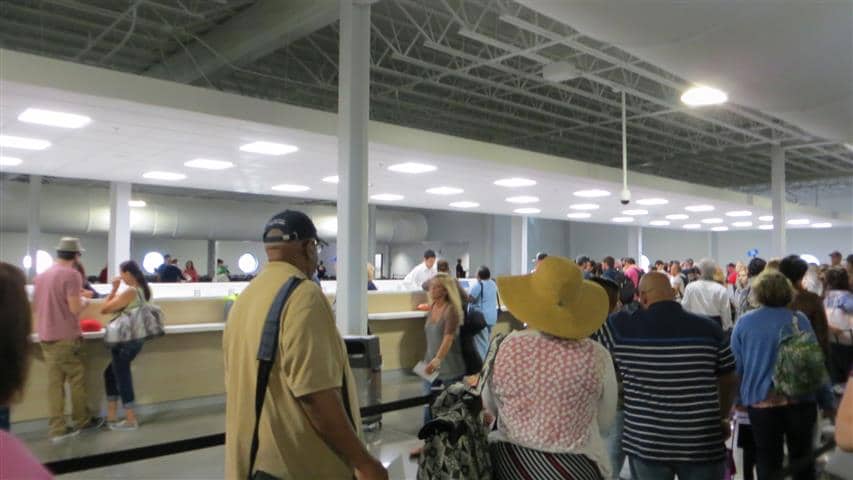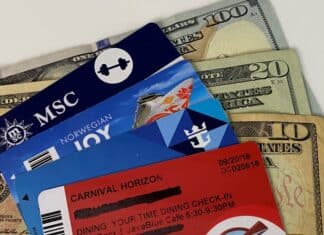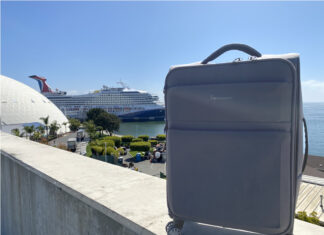If you’re a first-time cruiser, wondering what to expect at the port can be nerve-wracking. With so many rules and regulations regarding air travel these days, then it’s easy to think that taking a cruise will be similar.
The truth is, while there are some similarities to air travel, it’s actually much less stressful to board a cruise. And to help you prepare for your trip, we’ve explained what you can expect from when you arrive at the port to when you actually board the ship.
Arriving at the Cruise Terminal
When you arrive at the cruise terminal, it might seem a little crazy at first. Usually the first thing that people notice is just how massive cruise ships actually are when you’re standing right next to them.
The second thing they notice is that the port is busy. In a single day the average cruise ship is letting off about 4,000 passengers and replacing them with another 4,000 people. At the same time they are resupplying for another cruise. In other words, the port is always a hive of activity.
That might sounds like it would be easy to get turned around. Fortunately, the cruise lines and the port always make it simple to find your way. There will be signs posted clearly telling you exactly where to go. As well, employees of the port are always on hand to help lead people in the right direction.
If you are being dropped off at the port from your hotel or with a shuttle, they will know exactly where to go.
Once you arrive, you’ll typically check any bags that you don’t want to carry aboard the ship. Porters will take your bags, which will then be taken aboard and delivered to your cabin later. It’s important that you take anything you might need for the first day (such as boarding documents, prescriptions, a change of clothes, etc.)
Going Through Security
After dropping off your larger luggage, you’ll go through security. Security is similar to what you’ll find at an airport, however, there are some major differences.
Like in an airport, you’ll need to show ID and a boarding pass, as well as place your bags in an x-ray machine to be scanned. You will also pass through a metal detector. If the metal detector goes off, you will likely be wanded to find what the issue is.
Where security is different from an airport is that the security team in place is private security hired out — they are not the blue-shirted TSA agents. As well, there is no “body scanners” that see through your clothes to see anything concealed on your body. Because of this, you don’t have to empty your pockets. You just have to remove any metal objects.
You’ll also be happy to know that the 3-ounce liquid rules don’t apply to cruise ship security. If you want to bring a full bottle of shampoo, it’s allowed.
There are also no intrusive pat-downs like what you might see at an airport and you don’t have to remove belts or shoes in order to clear security.
Bottom line: While cruise security may look similar to what you find at the airport, it’s usually much less intrusive for passengers. You can read more details about going through cruise security here.
Check-In

After security, the next stage is check-in. This is becoming an area that’s rapidly changing. Some cruise lines are moving toward a system where you complete much of the check-in process online before you arrive, making it faster to board the ship come cruise day.
For most people, however, check-in involves heading to a large room with dozens of check-in agents. Here, you’ll stand in line until it’s your turn to approach the counter.
Once you’re with an agent, the process if relatively straightforward. They will check your travel documents and fill out any needed paperwork, including a credit card to link with your room account and a health questionnaire to make sure passengers with noroviruses are not boarding. The agent will also give you your most important item — your credit-card style room key that is linked to your onboard spending account.
In total, check-in is usually a quick process — just 5-10 minutes until you’re ready to board.
Boarding the Ship
Past check-in, the next step is the most fun — boarding. The walk to the ship can be surprisingly long. Not only do you have to go up several stories to reach the boarding deck, but it also usually involves walking to the mid-point of the ship. Depending on where it docked, this can be a few minutes walk away. Don’t worry if you have trouble getting around there are elevators and wheelchairs to help those with mobility issues.
On your walk to the ship you’ll also be asked to post for an embarkation photo. This is a souvenir picture in front of a backdrop with the ship on it. These photos are free to take and will be available for purchase on the ship if you want to take a copy home. If you don’t want to have your picture taken, you can politely decline.
Once you arrive on the ship, you’ll be asked to scan your card so that the crew knows you are actually onboard. There will be staff on hand to answer any questions you have and to help direct you to your cabin.
Have other questions about boarding your cruise? Let us know in the comments below.













First time cruisers/ 25th wedding anniversary,
I,m confused about the purchasing process. Do we put/pay cash on our cabin entry card or how does that work? We were told that we pay cash not with credit cards.
Congrats on the 25th! Are you asking about purchasing things on board the ship? You room card is used like a credit card on the ship. You want a drink? Order and hand your room card to the bartender. They will swipe it and it’s charged to your account. At the end of the trip, these charges are paid with a credit card you have on file (either enter your details online ahead of time or you can provide it at registration). You can also use cash if you prefer, but you’ll have to provide at least a couple of hundred bucks when your check-in. Most people use a credit card because it’s much more convenient since you don’t know exactly what you’ll spend.
What’s the process for carrying on our bottle of wine? I know it says to put it in our carry on bags. Is there a designated space for checking it in and/or paying the corkage fee?
There’s no real process. Just bring it on with you. The security staff may want to take a look to make sure it hasn’t been tampered with. The corkage fee is something you might see if you bring it with you to a restaurant on the ship. Many people just have the bottle in their room and pour a glass to walk around the ship or enjoy on the balcony.
First time cruiser! 😁
I will be with a friend who’s been on a cruise before so the process should easy for me. By the way, thanks for the helpful info. Looking forward to cruising the beautiful ocean/sea 🛳⚓
I not only have anxiety over escalators, but I get vertigo from tall bridge walkways with only light railings. Is there a picture of the walkway on to the boarding deck so I can be prepared?
Jon, the walkway is usually a fully enclosed bridge with glass windows to see out. Imagine a walkway to an airplane — it’s like that, but with windows instead of just walls.
Hello, I have a fear of escalators and steep stairs. If I don’t have a mobile disability, would I still be able to use the elevator to board the ship?
There are always elevators available for passengers in the terminal to get to the boarding deck. They can be used by anyone.